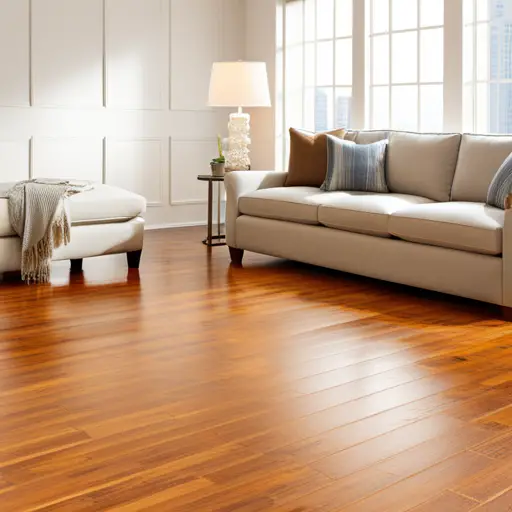When considering flooring options for a new or renovated space, homeowners are often faced with the choice between bamboo and hardwood flooring. Both materials offer a range of benefits and aesthetic appeal, but they come from distinctly different sources and have varying impacts on the environment.
Bamboo flooring, made from the fast-growing bamboo plant, has surged in popularity due to its sustainability and environmental friendliness.
Hardwood floors, on the other hand, are crafted from trees that take decades to mature, offering a traditional and timeless appeal.
In an era where environmental concerns are at the forefront of consumers’ minds, the demand for eco-friendly flooring options has notably increased, making bamboo an increasingly attractive option for those looking to combine style with sustainability.
Origin and Material
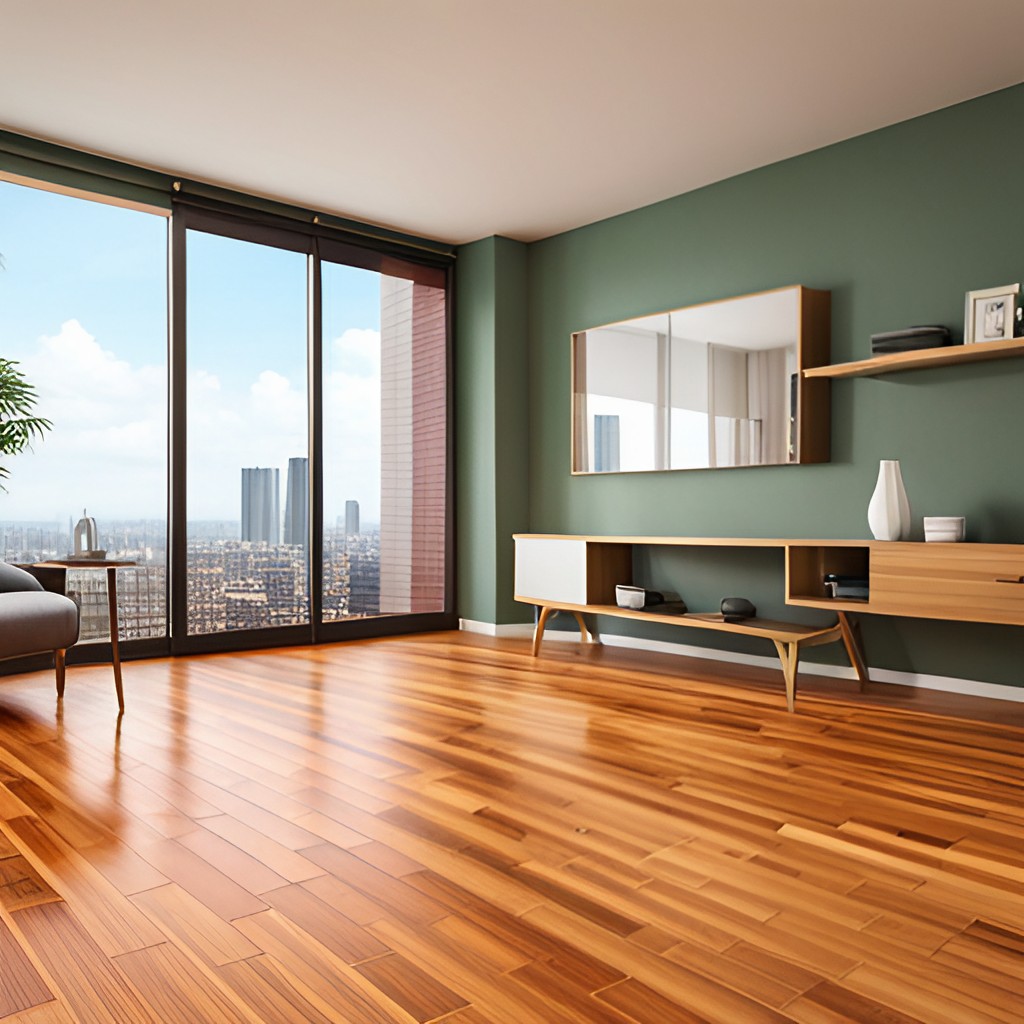
Source of Materials
Bamboo flooring originates from the bamboo plant, which is technically classified as a type of grass rather than wood. This grass has an impressive growth rate, with some species capable of growing up to 35 inches within a single day.
This rapid growth cycle enables bamboo to be harvested approximately every five to seven years, making it a highly renewable resource. In contrast, hardwood flooring materials are derived from deciduous trees, such as oak, maple, and walnut, which can take anywhere from 40 to 60 years to reach maturity.
This elongated growth period significantly limits the rate at which these resources can be replenished, making hardwood a less sustainable option than bamboo.
The sustainability of bamboo, coupled with its wood-like durability, positions it as an environmentally conscious choice for flooring without sacrificing the aesthetic and tactile qualities many consumers desire in hardwood floors.
Environmental Impact
The environmental benefits of choosing bamboo over traditional hardwood floors extend beyond its rapid renewability. Bamboo plays a substantial role in reducing the overall carbon footprint associated with flooring materials.
Plants, throughout their growth cycle, absorb carbon dioxide from the atmosphere, a process known as carbon sequestration. Given bamboo’s fast rate of growth, it sequesters carbon at a significantly higher rate compared to slow-growing hardwood trees.
This means that bamboo not only quickly replenishes itself but also contributes to the mitigation of global warming by absorbing higher amounts of CO2 within a shorter span of time.
Furthermore, bamboo plantations are often established on degraded lands and do not require high-quality agricultural land that could otherwise be used for food production.
This utilization of land supports environmental recovery and enhances soil quality without competing with essential food crops.
In contrast, hardwood forests sometimes require the clearing of virgin forests, which can lead to loss of biodiversity, ecosystem degradation, and increased carbon emissions. In this regard, bamboo flooring presents an eco-friendly alternative by minimizing deforestation and its associated environmental impact.
Additionally, the manufacturing process of bamboo flooring typically involves less energy consumption and produces fewer pollutants compared to hardwood flooring production.
Many companies specializing in bamboo flooring adhere to environmentally responsible practices, such as using low-VOC (volatile organic compounds) adhesives and finishes, further amplifying its green credentials.
These practices not only reduce harmful emissions but also ensure indoor air quality is maintained, making bamboo floors a safer and more sustainable choice for both the planet and its inhabitants.
Durability and Resistance

Hardness & Durability
Bamboo flooring is renowned for its exceptional hardness and durability, often surpassing many traditional hardwoods in this aspect.
The Janka hardness test, a measure of the resistance of wood to denting and wear, places certain types of strand-woven bamboo significantly higher than most hardwoods, making it an excellent choice for high-traffic areas.
Strand-woven bamboo, created by compressing bamboo fibers under high pressure, achieves Janka ratings that can compete with or even exceed those of the toughest hardwoods, like oak, maple, and hickory.
The inherent strength of bamboo stems from its natural growth patterns and the efficient manufacturing processes that enhance its resilience.
Unlike hardwood trees, which can take decades to mature, bamboo reaches its full hardness within five to seven years, providing a renewable source of material that does not compromise on strength or durability.
However, it’s crucial to note that the quality and performance of bamboo flooring can vary significantly depending on the manufacturing process and the type of bamboo used.
High-quality, properly harvested bamboo, especially strand-woven types, offers superior durability and resistance to wear and tear, making it suitable for both residential and commercial settings.
Comparatively, while hardwood floors are prized for their beauty and longevity, their durability can vary widely among species and is significantly affected by their environment and maintenance.
Hardwoods are susceptible to scratching and water damage, which can diminish their appearance and integrity over time.
The choice between bamboo and hardwood in terms of hardness and durability ultimately hinges on the specific needs of the application, including foot traffic, exposure to moisture, and desired aesthetic.
Moisture and Scratch Resistance
The resistance of flooring materials to moisture and scratches is paramount for maintaining their appearance and structural integrity over time. Bamboo flooring, particularly when properly finished, exhibits commendable resistance to moisture compared to traditional hardwoods.
Its natural fibrous structure allows it to absorb and release moisture more efficiently, reducing the risk of warping and swelling that is often associated with hardwood floors.
However, it is critical to distinguish between the different types of bamboo flooring; engineered bamboo has a higher resistance to moisture due to its construction, making it a more suitable option for areas prone to moisture fluctuations.
Scratch resistance is another essential factor to consider in flooring choices. Strand-woven bamboo, renowned for its toughness, offers a higher level of scratch resistance than both traditional bamboo and many hardwoods.
This resistance is largely attributable to the manufacturing process, where bamboo strands are compressed under high pressure, enhancing the floor’s density and, consequently, its ability to withstand scratches and dents.
Additionally, most bamboo flooring is treated with modern finishes that further protect it from everyday wear and tear.
It’s imperative for buyers to seek specific bamboo flooring types that have been designed and tested for high resistance to scratches and moisture, ensuring the longevity and durability of the flooring in various environmental conditions.
Regular maintenance and the use of protective sealants can also significantly contribute to maximizing the lifespan and appearance of bamboo flooring.
Installation
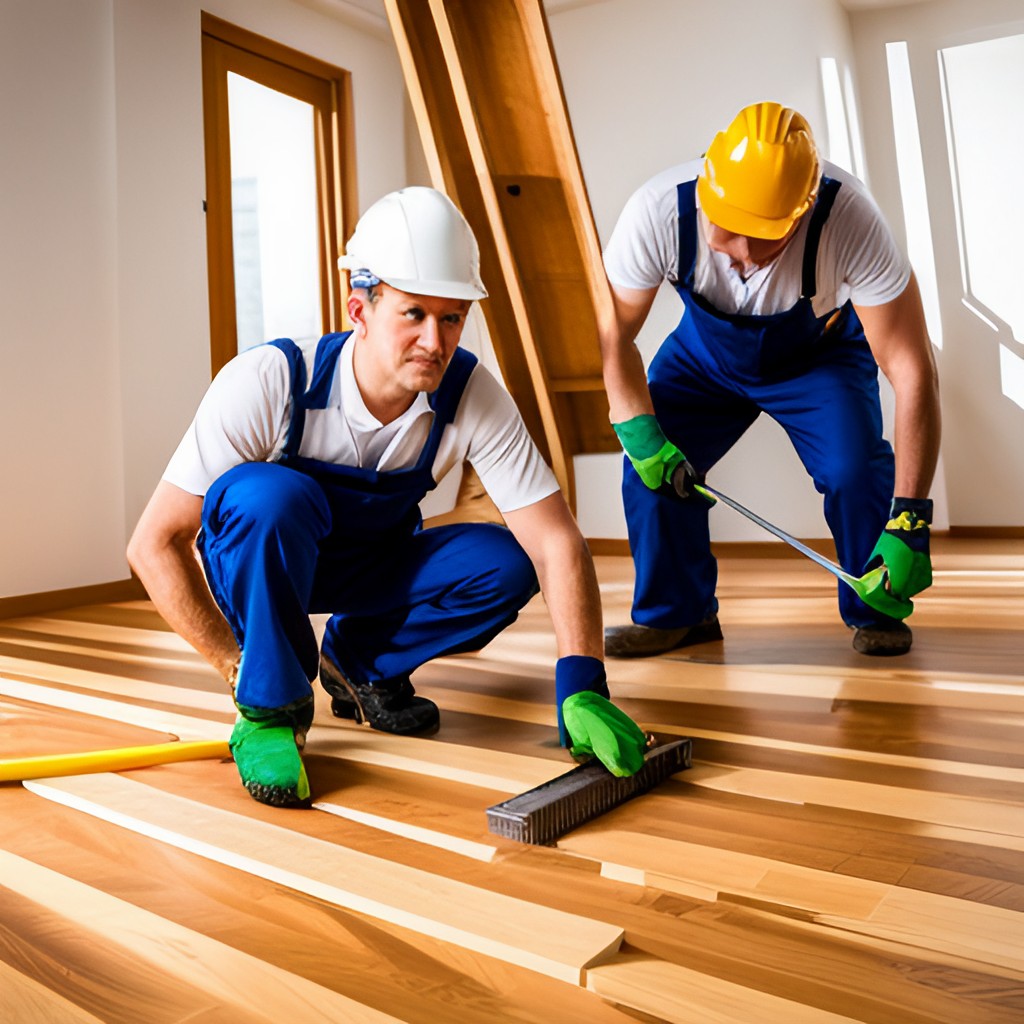
Ease of Installation
When considering the installation of bamboo flooring, it is paramount to understand that the simplicity and efficiency of the process vary depending on the flooring type and the method chosen.
Bamboo flooring can be installed through several methods, including floating (where the floor is not glued or nailed down), gluing down to a subfloor, or nailing down to a wooden subfloor.
Each method has its particulars and suitability depending on the bamboo flooring type and the characteristics of the installation site.
Floating Installation:
This method is notably user-friendly and minimally invasive, making it an excellent option for DIY enthusiasts. Engineered bamboo floors are particularly well-suited for floating installations because they are designed to click together easily, eliminating the need for nails or glue.
This method facilitates quick installation and allows for easy disassembly, should the floor need to be replaced or moved.
Gluing Down:
When a more permanent solution is preferred, gluing down bamboo flooring to a concrete or wooden subfloor ensures stability and longevity.
It’s crucial to use the appropriate adhesive recommended by the flooring manufacturer, as this will prevent moisture damage and ensure the adhesive’s compatibility with bamboo.
This method requires more preparation and precision, as the floor must be even and the adhesive evenly applied.
Nailing Down:
Traditional bamboo floors are often installed by nailing them down to a wooden subfloor. This method is highly durable and stable, making it suitable for areas with heavy foot traffic.
However, it requires the right tools and skills, as improper installation can lead to damage to the bamboo planks or the subfloor.
Ease of Installation
The installation process of bamboo flooring, though straightforward, varies significantly in complexity and duration depending on the chosen method.
The Floating Floor technique is notably user-friendly, and appealing to DIY enthusiasts due to its simplicity and the minimal tools required.
It enables individuals with basic home improvement skills to achieve a professional-looking finish without the need for specialized equipment or extensive experience.
Conversely, the Gluing Down and Nailing Down methods demand a higher level of precision and preparation. Ensuring the subfloor’s evenness, selecting the correct adhesive, and possessing the necessary tools and skills are imperative for a successful installation.
These methods, while more time-consuming and requiring a greater degree of technical knowledge, offer increased durability and stability, making them preferred options for high-traffic areas and commercial spaces.
Regardless of the method, the key to a seamless installation lies in meticulous preparation and adherence to the manufacturer’s instructions.
For those uncertain about tackling the installation independently, professional flooring installers can guarantee a swift and efficient process, mitigating the risk of errors that could compromise the floor’s appearance and longevity.
Aesthetic and Style
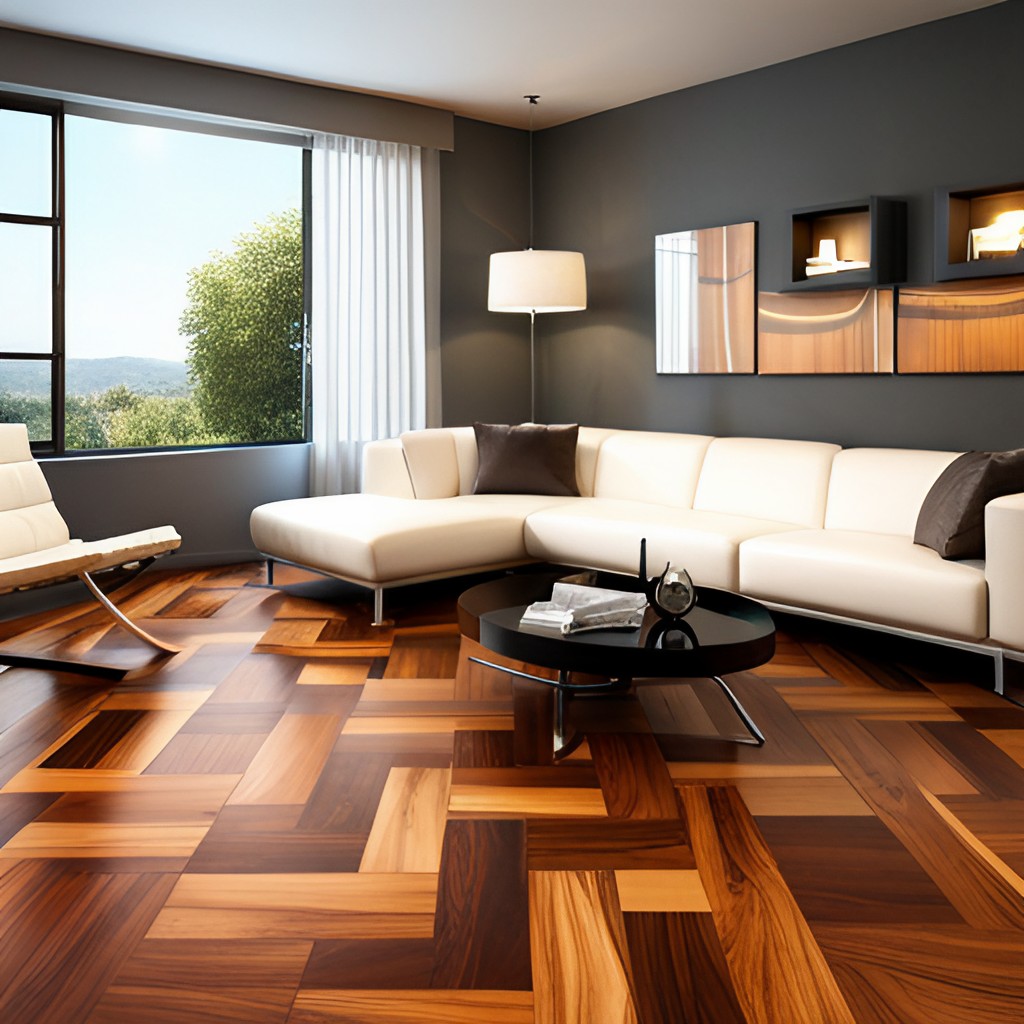
Variety in Designs and Finishes
Bamboo flooring offers an impressive array of designs and finishes that cater to every aesthetic preference, enabling homeowners and designers to achieve a personalized and stylish look for any interior space.
The natural variations in bamboo’s color and grain produce unique patterns, which are further enhanced through different manufacturing processes.
For instance, horizontal and vertical grain orientation presents distinct visual effects, with horizontal showcasing a broader, more traditional bamboo look, while vertical offers a sleek, contemporary appearance.
Furthermore, bamboo can undergo carbonization, where heat is applied to darken the bamboo, providing a richer, warmer tone.
This method adds depth to the bamboo’s natural color, ranging from light amber to deeper browns, without the need for artificial dyes or stains.
Beyond color and grain, bamboo flooring is available in an array of finishes that not only influence the floor’s aesthetics but also its durability and maintenance needs.
Finishes can vary from matte to high gloss, and some are integrated with UV inhibitors to prevent fading over time. More advanced finishes include scratch-resistant layers or anti-microbial coatings, enhancing the floor’s resilience to wear and promoting a healthier indoor environment.
Choosing the right design and finish involves considering both the visual impact and practicality of the flooring.
It’s essential to balance the aesthetic appeal with the functionality to ensure the bamboo flooring complements the lifestyle of the occupants and withstands the demands of the space it inhabits.
Adaptation to Interior Designs
Bamboo flooring’s versatility is paramount in its adaptation to various interior design styles, from minimalist and modern to rustic and traditional.
The key to bamboo flooring’s compatibility lies in its diverse range of colors, grains, and finishes, which can be selected to complement or contrast with the overall design scheme of a room.
Minimalist and Contemporary Settings:
For interiors adhering to minimalist principles or contemporary design, bamboo flooring with a vertical grain and a matte or satin finish is ideal.
This combination accentuates the sleek lines and simplicity of modern decor, providing a subtle, sophisticated backdrop that enhances the sense of space. The use of lighter shades or naturally carbonized bamboo can also introduce warmth to a minimalist aesthetic without overwhelming the senses.
Traditional and Classic Interiors:
In more traditional settings, bamboo flooring with a horizontal grain presents a more pronounced pattern that echoes the natural beauty of bamboo.
When combined with a high-gloss finish, it adds an element of luxury and depth, making it a perfect match for classic and vintage interior designs.
Choosing darker, carbonized hues can lend a sense of timelessness and grandeur, ideally complementing antique furnishings and rich color palettes.
Rustic and Country Designs:
For those aiming to achieve a rustic or country look, hand-scraped bamboo flooring is exceptionally fitting. This style features an intentionally distressed surface that mimics the wear and character of reclaimed wood.
Paired with warm, earthy tones, it enhances the cozy, lived-in feel characteristic of country-inspired homes. The texture and depth of hand-scraped bamboo also provide a tactile dimension that enriches the natural, informal charm of rustic interiors.
Incorporating bamboo flooring into an interior design project requires thoughtful consideration of the interplay between the floor’s characteristics and the room’s overall theme.
Maintenance and Care
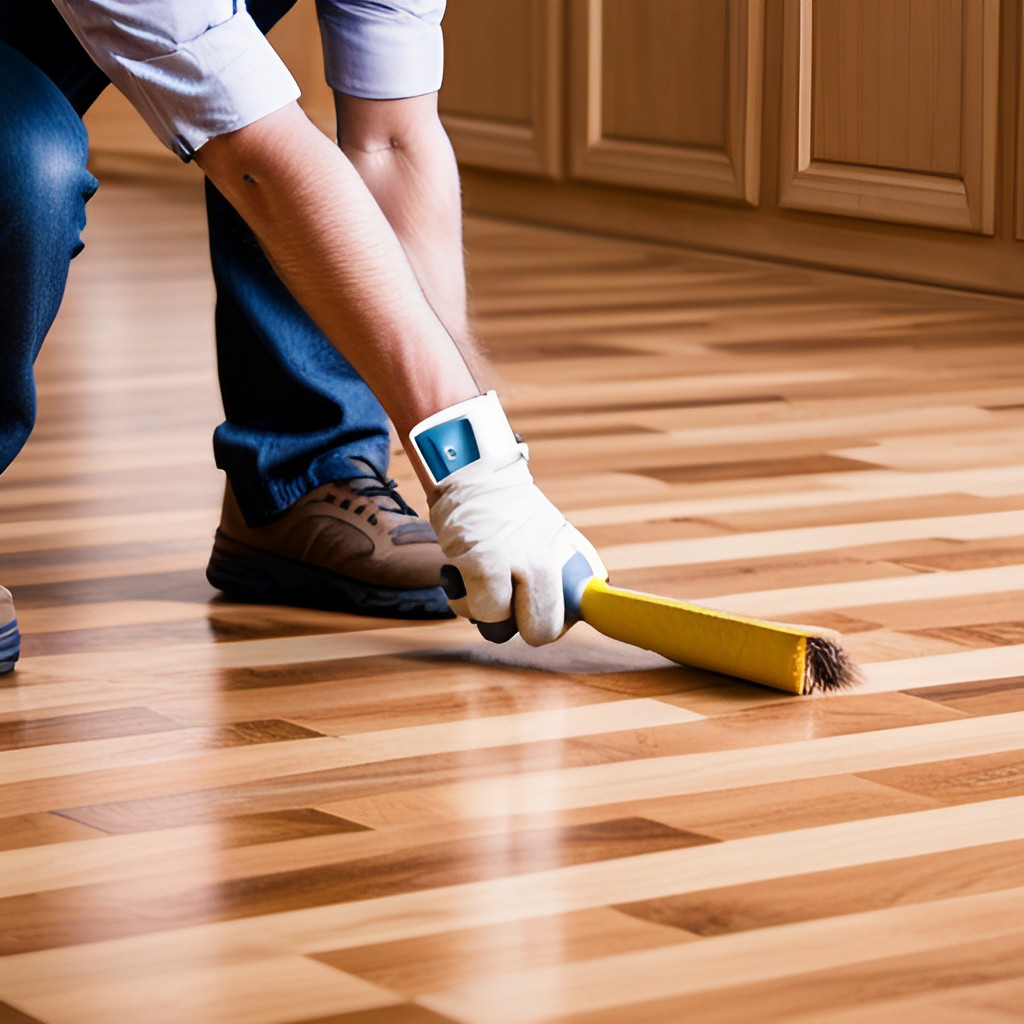
Cleaning Methods
Proper maintenance and cleaning are pivotal to preserving the beauty and longevity of bamboo flooring. Adhere to the following methods to ensure your bamboo floors remain in pristine condition:
Regular Sweeping or Vacuuming:
To prevent the accumulation of dirt and grit that can scratch the floor’s surface, sweep or vacuum your bamboo floors regularly. It’s crucial to use a soft-bristled attachment or a microfiber mop to avoid any potential damage.
Mopping with a Damp Cloth:
A key aspect of maintaining bamboo flooring involves careful mopping. Employ a damp mop rather than a wet one to clean the floors. Excessive water can seep into the bamboo, causing it to swell, warp, or become discolored.
For optimal results, use a mild detergent or a specific bamboo floor cleaner diluted in water. After mopping with the solution, go over the floor with a clean, dry mop to remove any lingering moisture.
Immediate Spill Cleanup:
Spills should be promptly addressed to prevent water damage or staining. Wipe spills immediately with a dry cloth or paper towel.
For sticky or oily spills, a slightly damp cloth can be used, followed by a dry towel to ensure no moisture remains on the surface.
Avoid Harsh Chemicals:
Harsh cleaning agents, such as ammonia or bleach, can damage bamboo floors. Always opt for pH-neutral cleaners specifically designed for hardwood or bamboo flooring.
These solutions maintain the integrity of the bamboo’s surface and finish.
Protective Measures:
Beyond cleaning, protect your bamboo flooring by placing felt pads under furniture legs to prevent scratching. Rugs and mats at entrances can help catch dirt and grit that may otherwise be tracked across the floor, potentially scratching the surface.
Long-Term Maintenance
Long-term maintenance of bamboo flooring is critical for preserving its beauty and extending its lifespan. This involves several detailed practices that go beyond the routine cleaning procedures.
Regular Inspections:
At least twice a year, inspect your bamboo floors for any signs of wear or damage. Look for scratches, dents, and areas where the finish may be wearing off. Early detection of these issues can prevent more significant damage and costly repairs in the future.
Refinishing Periodically:
Depending on the traffic and wear, bamboo floors may require refinishing every few years. This process involves sanding down the surface layer and then applying a new topcoat finish.
Refinishing can significantly renew the appearance of your floors and protect them from future wear.
Maintain Humidity Levels:
Bamboo floors are sensitive to changes in humidity, which can cause them to expand or contract. Maintaining a stable indoor humidity level (ideally between 35% to 55%) can prevent warping, buckling, or gaps between planks.
Deep Cleaning:
Schedule a professional deep cleaning or take the task upon yourself to thoroughly clean the floors at least once a year. This deeper cleaning should remove grime and buildup that regular cleaning can miss, maintaining the bamboo’s natural luster.
Cost
Initial Costs & Long-Term Value
The decision to install bamboo flooring should be carefully considered, weighing the initial costs against the long-term value. Initial costs involve not only the price of the materials but also installation expenses.
Prices can vary widely based on the quality of the bamboo, with higher-quality materials commanding a premium. Installation costs can also fluctuate based on the complexity of the project and the rates charged by contractors.
Collectively, these expenses establish the initial financial outlay required to install bamboo flooring in your home.
However, it’s crucial to assess the long-term value bamboo flooring provides. Bamboo floors are renowned for their durability, eco-friendliness, and aesthetic appeal, factors that can significantly enhance the overall value of your home.
Properly maintained bamboo flooring can last for decades, making it a cost-effective choice in the long run.
The resilience of bamboo means it can withstand the rigors of daily life, potentially saving homeowners on replacement or extensive repair costs associated with less durable flooring options.
Cost-Effectiveness Over Time
Bamboo flooring stands out as an exceptionally cost-effective choice when considering its lifespan and minimal maintenance requirements.
The long-term savings associated with bamboo flooring become evident through its durability and low upkeep costs.
Unlike traditional hardwood, bamboo is more resistant to water damage, stains, and wear, reducing the need for frequent replacements or costly repairs.
Furthermore, bamboo’s natural resistance to pests and mold contributes to its longevity, ensuring that it remains in pristine condition for longer periods.
The cost-effectiveness of bamboo flooring is further highlighted by its impact on property value. Homes with bamboo floors often attract higher resale values due to the material’s desirability among eco-conscious buyers and those looking for homes with modern and sustainable features.
Therefore, the initial higher expenditure on bamboo flooring should be viewed as an investment that will pay dividends over time, not only through reduced maintenance and repair costs but also by adding to the property’s market value.
Environmental Impact

Sustainability Comparison
Bamboo stands as a highly sustainable alternative to traditional hardwood flooring due to its rapid growth rate and renewable nature. Unlike hardwood trees which can take upwards of twenty to fifty years to reach maturity, bamboo can be harvested within three to five years.
This significant difference in growth rates means bamboo can be replenished much faster than hardwood, ensuring a more sustainable cycle of use and production.
Bamboo’s sustainability is further amplified by its ability to grow in a variety of climates without the need for harmful pesticides or fertilizers, reducing its environmental impact.
Deforestation and Ecology
The production of bamboo flooring has a markedly lower contribution to global deforestation compared to traditional hardwood sources. Hardwood logging is a primary driver of forest degradation and habitat loss, significantly impacting global biodiversity and carbon sequestration capacities.
In contrast, bamboo cultivation supports ecological balance by enhancing soil health and preventing erosion due to its extensive root system.
Furthermore, the adaptability of bamboo allows it to be farmed on lands unsuitable for other crops, limiting the encroachment into natural forests and preserving vital ecosystems.
Related Topics:
Conclusion
In comparing bamboo and hardwood flooring, bamboo emerges as a compelling option for both environmentally conscious consumers and those seeking durability and aesthetic appeal.
Its rapid renewability and lower environmental impact highlight bamboo’s role in fostering a more sustainable future in building materials. While hardwood flooring offers traditional charm and timeless quality, bamboo introduces innovative qualities such as superior sustainability, comparable or superior durability, and a unique aesthetic.
Additionally, bamboo flooring’s adaptability across various interior designs, coupled with its ease of installation and maintenance, renders it an attractive choice for modern homes.
Homeowners and designers alike must weigh these factors carefully, considering both immediate and long-term environmental impacts, costs, and their specific needs to make an informed decision.
Ultimately, bamboo flooring stands not only as an eco-friendly alternative but as a testament to the possibilities of sustainable living without compromise on quality, functionality, or style.
